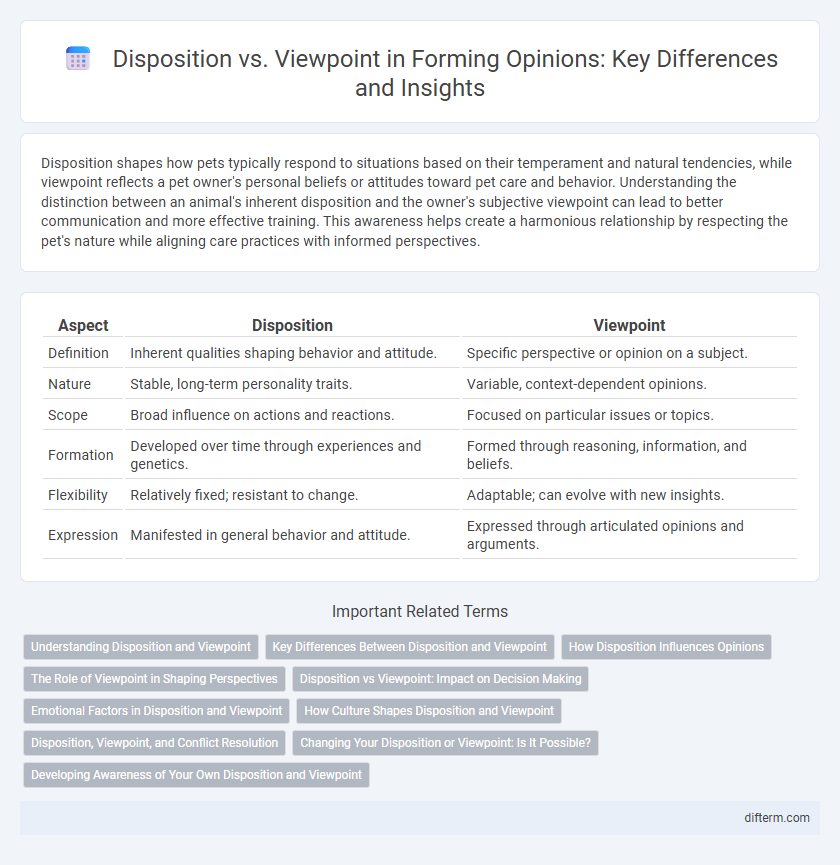Disposition shapes how pets typically respond to situations based on their temperament and natural tendencies, while viewpoint reflects a pet owner's personal beliefs or attitudes toward pet care and behavior. Understanding the distinction between an animal's inherent disposition and the owner's subjective viewpoint can lead to better communication and more effective training. This awareness helps create a harmonious relationship by respecting the pet's nature while aligning care practices with informed perspectives.
Table of Comparison
| Aspect | Disposition | Viewpoint |
|---|---|---|
| Definition | Inherent qualities shaping behavior and attitude. | Specific perspective or opinion on a subject. |
| Nature | Stable, long-term personality traits. | Variable, context-dependent opinions. |
| Scope | Broad influence on actions and reactions. | Focused on particular issues or topics. |
| Formation | Developed over time through experiences and genetics. | Formed through reasoning, information, and beliefs. |
| Flexibility | Relatively fixed; resistant to change. | Adaptable; can evolve with new insights. |
| Expression | Manifested in general behavior and attitude. | Expressed through articulated opinions and arguments. |
Understanding Disposition and Viewpoint
Disposition refers to an individual's inherent qualities of mind and character that influence habitual attitudes and responses, while viewpoint is the specific perspective or stance one takes on a particular issue. Understanding disposition involves recognizing enduring traits that shape general behavior, whereas grasping viewpoint requires analyzing the context and reasoning behind a person's opinion. Differentiating these concepts enhances clarity in interpreting attitudes and opinions across various discussions.
Key Differences Between Disposition and Viewpoint
Disposition refers to an individual's inherent qualities of mind and character that shape consistent behavioral tendencies, while viewpoint denotes a specific attitude or opinion about a particular subject at a given time. Disposition is relatively stable and influences how a person generally reacts across various situations, whereas viewpoint is more flexible and can change based on new information or experiences. Understanding these key differences enhances clarity in psychological analysis and effective communication.
How Disposition Influences Opinions
Disposition profoundly shapes opinions by coloring how individuals interpret information and assess situations based on their inherent attitudes and emotional tendencies. People with a positive disposition tend to form optimistic viewpoints, while those with a negative disposition are more likely to develop critical or pessimistic opinions. This intrinsic bias affects not only personal judgments but also social interactions and decision-making processes.
The Role of Viewpoint in Shaping Perspectives
Viewpoint plays a critical role in shaping perspectives by influencing how individuals interpret information and experiences through their unique lens of beliefs and values. Unlike disposition, which reflects inherent personality traits, viewpoint is shaped by cultural, social, and contextual factors that guide judgment and decision-making. A nuanced understanding of differing viewpoints fosters empathy and broadens the scope of discourse in any opinion-based discussion.
Disposition vs Viewpoint: Impact on Decision Making
Disposition influences decision making by shaping habitual responses and emotional biases, which can limit objective analysis of a situation. Viewpoint offers a more flexible perspective, allowing individuals to consider alternative angles and adapt their judgments based on new information. Understanding the distinction between disposition and viewpoint is crucial for improving critical thinking and making balanced, well-informed decisions.
Emotional Factors in Disposition and Viewpoint
Emotional factors deeply shape both disposition and viewpoint, influencing how individuals perceive and react to information. A disposition reflects an enduring emotional tendency that colors judgments and behaviors over time, while a viewpoint captures a more immediate emotional response to specific situations or arguments. Understanding these emotional underpinnings helps clarify why people hold persistent attitudes or shift opinions based on emotional resonance.
How Culture Shapes Disposition and Viewpoint
Culture profoundly influences disposition by ingraining values and habitual responses that shape how individuals perceive and react to situations. Viewpoints, molded by cultural narratives and shared experiences, reflect collective interpretations that guide understanding and judgment. The interplay between culturally conditioned disposition and viewpoint creates diverse cognitive frameworks that affect decision-making across societies.
Disposition, Viewpoint, and Conflict Resolution
Disposition shapes how individuals approach conflict resolution by influencing emotional responses and openness to compromise, while viewpoint reflects specific beliefs or perspectives within the conflict. A cooperative disposition fosters constructive dialogue and effective problem-solving, reducing the likelihood of escalation. Understanding both disposition and viewpoint allows mediators to tailor strategies that address underlying attitudes and promote mutual understanding.
Changing Your Disposition or Viewpoint: Is It Possible?
Changing your disposition involves altering your fundamental attitudes and emotional outlook, which can be challenging but achievable through consistent self-awareness and deliberate practice. Shifting your viewpoint, on the other hand, often requires reevaluating beliefs and perspectives based on new information or experiences, making it more flexible and adaptable. Both processes play crucial roles in personal growth, as modifying disposition leads to long-term behavioral change while updating viewpoints allows for immediate cognitive adjustment.
Developing Awareness of Your Own Disposition and Viewpoint
Developing awareness of your own disposition and viewpoint enhances critical thinking by highlighting personal biases and emotional tendencies that shape perception. Recognizing the underlying disposition--an ingrained temperament--provides insight into habitual responses, while clarifying your viewpoint reveals specific stances formed through experiences and knowledge. This dual awareness fosters open-mindedness and enables more objective evaluation of diverse perspectives.
disposition vs viewpoint Infographic

 difterm.com
difterm.com